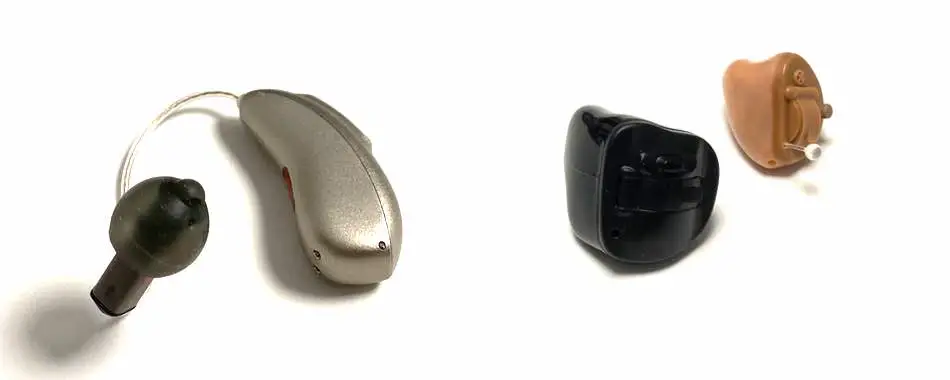When you are about to buy your next hearing aids you may wonder if in the ear or behind the ear hearing aids are generally better? After you read this article you will know the differences between them and which one might be better for you.
Your hearing care professional will look at your hearing loss in combination with the shape and size of your hearing loss to decide if in-the-ear or behind-the-ear hearing aids may work better for you. There some things to consider when we talk about both types of hearing aids.
This is predominantly moisture. When moisture enters the components of the hearing aids the ellectronics may malfunction. With in the ear hearing aids all the electronics sit in the ear which means moisture can fairly easily enter due to the little holes in the filter which sits right in front the receiver.
When the hearing aid shows a defect the whole systems needs to be send to the manufacturer for a repair. With wet ear canals hearing aids with a tube may which sit partillyy behind the ear may work better. The reason is no elecronics are directly placed in your ear. It is just a tube which guides the amlified sounds. All the electronics sit behind the ear.
But this is not true for all the devices there are also RIC hearing aids (Receiver in the canal). This means the loudspeaker is placed in the ear and the rest of the hearing aid is positioned behind the ear. Of course moisture could also lead to a defect here.
But when a defect occurs the loudspeaker can shwitched out to a new one. This is simply not possible with a in-the-ear hearing aid.
What Is the Difference Between Behind-the-Ear and in-the-Ear Hearing Aids?
The difference between them is that behind-the ear hearing aids consist of two main parts. One sits behind the ear and the sound is sent down the tube or through a cable in the ear piece which is the second part. In contrast a in-the ear hearing aid sits only in your ear canal.
Advantages of in-the-Ear Hearing Aids
- More inconspicuous than hearing aids that sit-behind-the-ear
- Make phone calls as usual. You simply hold the receiver to your ear. You can’t do that with hearing aids that sit behind the ear. Find out more here.
- The way of hearing is more natural. Pinna effects don’t have to be factored in.
- No rustling of hair on the microphones compared to behind-the-ear hearing aids.
- Easier selection when wearing glasses. The temples of the glasses have no contact with the hearing aids.
- Perfect performance of the hearing aid due to anatomical fit.
Disdvantages of in-the-Ear Hearing Aids
In-the-ear hearing aids are smaller and can be more difficult to handle if you have limited motor skills. The choice of which battery to select is somewhat less. Devices with recharchable batteries are only very seldom available. They are more prone to defects when it comes to moistrure.
The amplification of sound is not quite as strong behind the ear compared to devices, so ITE devices are primarily helpful for people who have only mild to moderate hearing loss.
While most people expect a very small device which is invisible to an observer in some cases this is not possible due to a very small ear canal. This means depening on the anatomy of your ears the in the ear hearing aid will be bigger or smaller.

Advantages of behind-the-Ear Hearing Aids
The main advantage is behind-the-ear hearing aids can be used with a wide range of hearing losses. There is hardly a variant of hearing loss that cannot be covered by the device worn behind the ear. Also, the anatomy of the ear do play less a role.
Those hearing aids can be worn even by children and generally people with small auricles. Most of the behind the ear hearing aids available are very small and lightweight and comfortable to wear. The format allows the use of more powerful batteries compared to ITE devices or rechargeable batteries.
They are easier to handle when the wearer has limited motor skills. The behind the ear hearing aids stay the same when you order them. The shape of the device does not change.
Disadvantages of behind-the-Ear Hearing Aids
The visibility for outsiders is perceived by many people as the biggest disadvantage. In addition, the models are usually less suitable for spectacle wearers because the spectacle temple does not allow the hearing aid to sit securely behind the ear.
Especially for very old wearers of hearing aids it is hard to use the telephone in combination with behind the ear hearing aids. The reason is the hearing aids pick up the sound on top of the ears. When the wearer of the hearing aids is used to place the phone where the ear canal is he or shewill not hear the person who calls properly because the lodspeaker is placed to low.
This means alll phones need to be hold higher so the behind the ear hearing aid can pick up the sound correctly from the telephone in order to amplifiy the sound.
Conclusion
The decision for a hearing aid in the ear or behind the ear depends on personal taste on the one hand and on the requirements for the device on the other. People with significant limitations in their hearing ability are well advised to use a BTE device. Those who wear glasses and wear face masks and have a rather mild to moderate hearing impairment can often fall back on a in-the-ear hearing aids.
